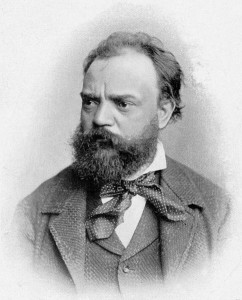Dvorak, Serenade for Winds
 Antonin Dvorak (1841-1904) was raised in the small village of Nelahozeves 20 miles north of Prague. The town is situated on the Vltava (Moldau), which runs through Prague and is a significant factor in Czech culture. Dvorak’s father was a butcher and innkeeper, but also an amateur musician. Young Antonin played the violin, so you might imagine him growing up with the local folk melodies that would accompanied social life at the inn.
Antonin Dvorak (1841-1904) was raised in the small village of Nelahozeves 20 miles north of Prague. The town is situated on the Vltava (Moldau), which runs through Prague and is a significant factor in Czech culture. Dvorak’s father was a butcher and innkeeper, but also an amateur musician. Young Antonin played the violin, so you might imagine him growing up with the local folk melodies that would accompanied social life at the inn.
Nationalism became a prominent movement in music in the late 19th century as composers in various locales sought to capture the unique sounds of their local culture. Dvorak, and before him Smetana, get the credit for bringing international attention to the Czech melodies and rhythms.
In this serenade, the wind instruments reinforce the folk sound that runs throughout. The first movement is a march similar to what you might find introducing a Mozart serenade. The second movement in particular emphasizes the folk elements with two Czech folk dances: a sousedska and, in the trio, a furiant. The sousedska is a somewhat slow dance in three similar to the Ländler. A furiant is a fast dance in three that typically shifts to a rhythm in pairs (i.e. accents on every other note). So you have 1 2 3 | 1 2 3 alternating with 1 2 3 | 1 2 3.
This serenade was well received at its premiere in 1878 and has remained popular since. Among its strong admirers was Brahms, who had begun championing Dvorak’s music somewhat earlier. Dvorak had won the Austrian State Prize for Composition in 1874, and Brahms had served as one of the judges. Dvorak was also a fan of Brahms and in this work followed the model of the Brahms Serenade op. 16 in many respects.
In thinking about Dvorak’s ability to capture folk themes in his compositions, remember that the second movement of his “New World” Symphony, written during his time in America, has become an iconic American melody (“Goin’ Home”) often mistaken as an American folk song.



